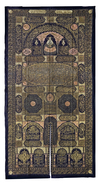AN IMPORTANT OTTOMAN METAL-THREAD EMBROIDERED CURTAIN MADE FOR THE DOOR OF THE KABAA (BURQA'), PERIOD OF SULTAN ABDUL-HAMID II, DATED 1304 AH/ 1886 AD
Of rectangular form, embroidered in silver and silver-gilt wire on a black silk ground, a slit in the middle of the lower part indicates the opening of the portal, the whole surface divided into eleven tiers decorated with verses from the Qur'an, Kalimaat al-Tawhid, and invocations to God in naskh and thuluth scripts incorporated within cartouches and medallions of embroidered wires on green, red and black grounds, a square above the portal opening incorporates the name of the Sultan Abdul Hamid II and the date 1304 AH, woven in gilt wire on a black ground, the interstices filled with intertwining stylised floral and vegetal motifs, the outer border decorated with squares containing mihrabs shaped designs enclosing each a Beautiful name of Allah. 580 by 290 cm
The inscriptions are as follows:
First tier: two cartouches enclosing v.1 from surah al-A'raf and v.22 from surah al-Hushr on a green ground, roundels enclosing each a Beautiful name of Allah. Second tier: Surat al-Ikhlas, flanked by two roundels containing the words Allah rabi (Allah is my Lord), central roundel contains the words Allah hasbi (Allah is sufficient unto me).
Third tier: 1. Basmallah followed by Surat al-Fatiha which is woven diagonally and horizontally in the outer border of the curtain. Surat al-Fatiha is interspersed with roundels containing the words Allah hasbi and Allah rabi. 2. Surat al-Naml verse 30, and Surat al-I'sraa' verse 80 within archway stylised with mosque lamps between Mihraab shaped columns w enclosing '' Ya Allah, Ya Fatah'', two upper roundels with ''Allah and Muahmmed'', two lower carouches enclosing Kalimaat al-Tawhid.
Fourth tier: Two cartouches incorporating, from right to left: the first and second parts of ayat al Kursi (The Throne Verse) from Surah al-Baqara, v.255, interspersed by roundels containing Allah rabi and Allah hasbi. Fifth tier: A panel containing the Basmallah and verse 27 from Surah al-Fath. Sixth tier: two cartouches incorporating the rest of Ayat al Kursi (The Throne Verse), interspersed by roundels containing Allah rabi and Allah hasbi.
Seventh tier: Two large octagonals incorporating the words ''Allah and Muhammed'', surah Al-Ikhlas and Quran 48 Al-Fath v. 29In the centre square with the dedication which states that '' This Honorable Purdah was ordered to be renovated during the reign of Sultan Abdul Hamid II, custodian of this Holy Mosque in the year 1304 AH/ 1886 AD''. Eighth tier: Basmallah and the beginning of Surah Quraish, the text separated in the middle by the opening of the portal, surrounding portal border containing v.53 from surah Az-Zumar.
Ninth tier: include the Shahadah, on the right side 'There is no God but Allah, The Supreme Power, the Lucid', and on the left side, 'Muhammad is the Messenger of Allah, The Truthful, The Faithful'. Tenth tier: two cartouches enclosing v.56 from surah al-Ahzab, flanked by roundels containing Allah rabi. Eleventh tier: The lower section with archways stylised with flowers and enclosing Quran v.144 from surah Al-Baqraa with two fans knotted by a ribbon and flower scrolls.
The curtains and bands that covered the Ka'ba were manufactured in Istanbul and Cairo, which was the centre of embroidery production during the Mamluk (13th-16th Centuries) and Ottoman (16th-20th Centuries) periods. It was customary to change the Kiswa, hizam, and burqa' annually on the 25th of the month of Dhu'l Qa'da. The plain black cloth was cut up in pieces and given as presents to dignitaries performing the annual pilgrimage or sold to pilgrims. However, the black silk brocade which was decorated with verses, religious inscriptions including verses from the Qur'an, words of the Shahadah and invocations to God, was returned to the Sultan in Istanbul. As a result the Topkapi Palace Museum houses the largest collection of curtains, bands and fragments. According to S. Venoit, 'The interior of the Ka'bah was protected by a Kiswah that was renewed every time a new Ottoman Sultan ascended the throne. This red and green covering was made in Istanbul from the 16th Century, along with a cover for the Black Stone. Also sent on the accession of a new Ottoman Sultan (or earlier if the existing fabric had decayed) was the curtain that screened the tomb of the Prophet in Medina. In the 18th Century the Kiswah for the exterior of the Ka'ba was manufactured in the Citadel in Cairo. No Kiswah was sent from Cairo in 1799 and 1800 during the French occupation of Egypt (1798-1801)'. Elaborate processions and ceremonies took place in Cairo and Istanbul after the manufacture of the cloths and before the departure of the caravans carrying them to their final destination in the holy cities of Mecca and Medina.





